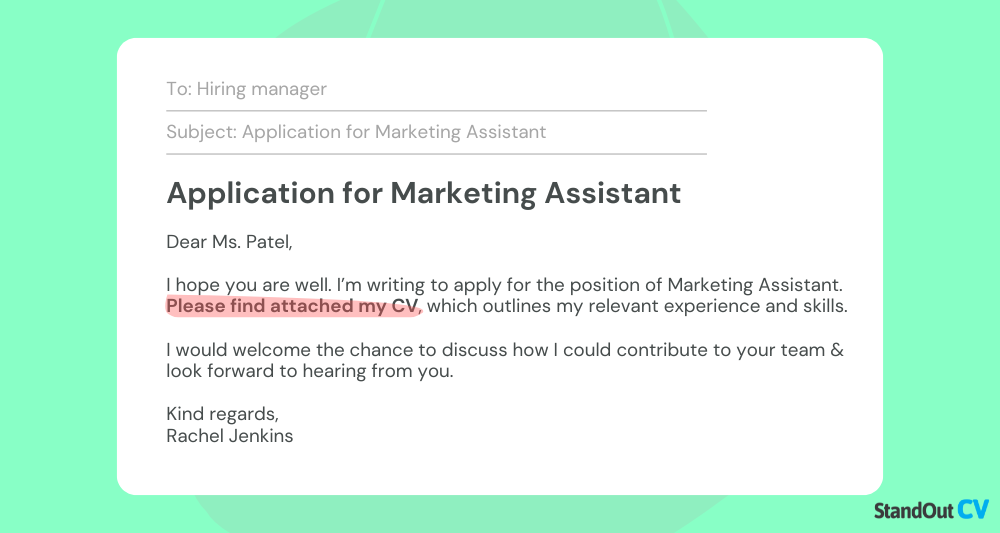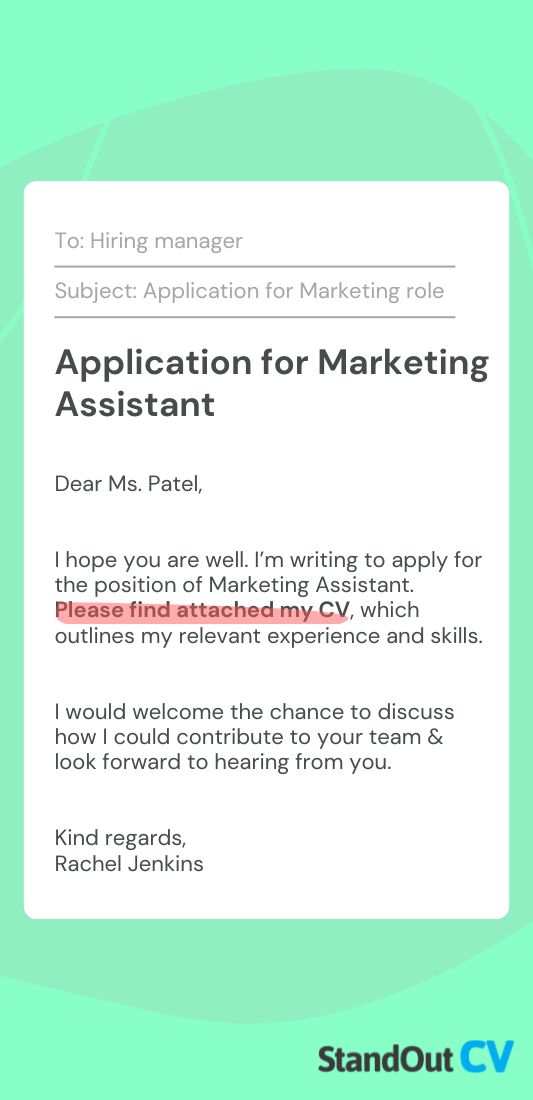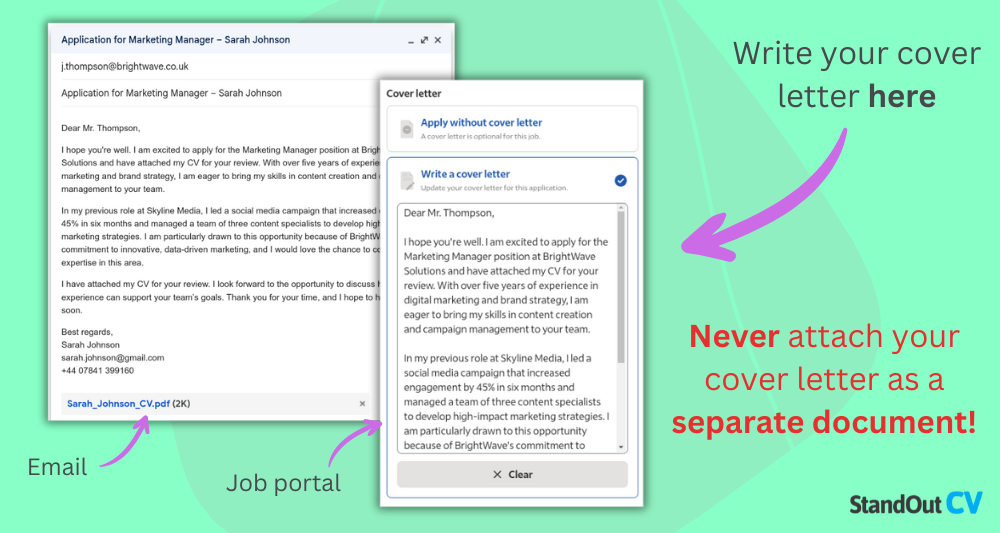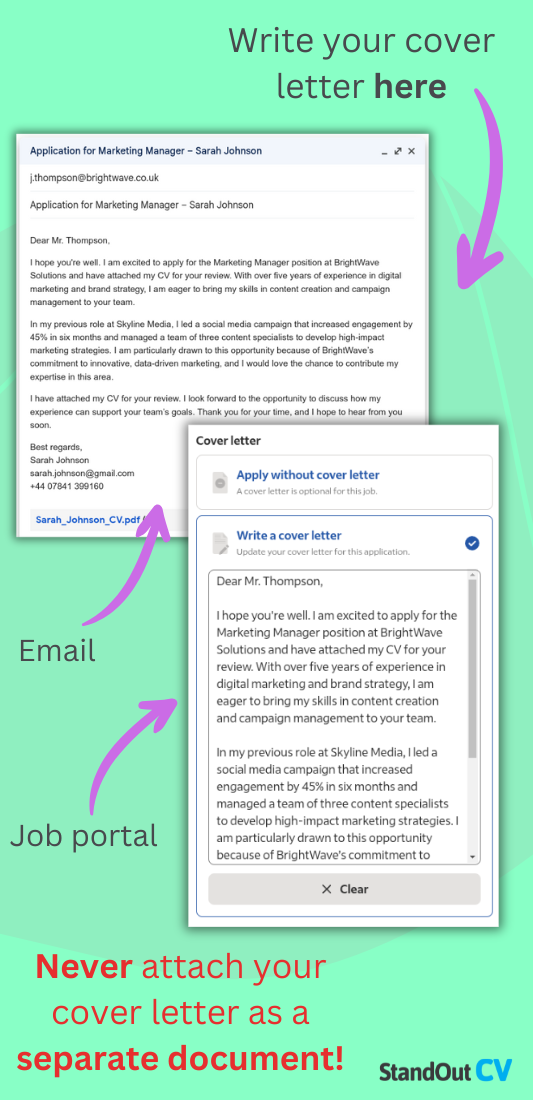Your CV is the most important document in your job application, so it’s crucial to make sure recruiters know it’s attached.
But let’s be honest, “please find attached my CV” can feel a little dated and overly formal, making your application seem more boring than engaging.
If you want to stand out while maintaining professionalism, it helps to use a phrase that feels more natural, confident, and suited to your industry.
This guide provides 50 alternatives to help you introduce your CV in a way that fits your tone and audience.
How to say “Please find attached my CV” but better
Professional and polished
These alternative ways of saying “please find my CV attached” are clear, direct, and professional – perfect for positions where a formal tone is expected. They ensure that your message is structured, professional, and leaves no room for confusion.
- “I have attached my CV for your review.”
- “Attached is my CV for your consideration.”
- “Please find my CV attached for your reference.”
- “You will find my CV attached to this email.”
- “I have enclosed my CV as requested.”
- “My CV is attached for your perusal.”
- “Here is my CV, attached for your convenience.”
- “As requested, I have included my CV as an attachment.”
- “I am sending my CV as an attachment for your review.”
- “Attached is my CV, and I look forward to your thoughts.”
✅ Best for: Corporate professionals, legal, finance, government roles, and executive positions.
Warm and conversational
If you want to sound approachable yet professional, these options strike a good balance. They make your email feel more natural while still keeping it clear that your CV is attached. This style works well in creative industries, where communication and relationship-building are valued.
- “I’ve attached my CV—please let me know if you have any questions!”
- “You’ll find my CV attached—happy to provide any further details!”
- “Just attaching my CV here for your reference.”
- “Sending over my CV for you to take a look at!”
- “I’ve popped my CV in this email for you.”
- “Attaching my CV—excited to chat more about the opportunity!”
- “I’ve included my CV here—let me know if you need anything else!”
- “Here’s my CV for your review—looking forward to your feedback!”
- “I’ve attached my CV—please feel free to reach out with any questions.”
- “Please find my CV attached—I appreciate your time reviewing it!”
✅ Best for: Marketing, PR, customer service, HR, hospitality, and creative industries.
Confident and direct
These variations are to the point and project confidence. They suggest that you’re proactive and enthusiastic, which is great for industries that value assertiveness and leadership. Sales, tech, and startups—where making a strong impression quickly matters—are great fits for this style.
- “My CV is attached for your review—looking forward to discussing further!”
- “Here’s my CV—happy to provide more details if needed!”
- “You’ll find my CV attached—please let me know if you need any more information.”
- “I have included my CV—let me know if you require any additional documents.”
- “I’m attaching my CV for your reference—looking forward to your response!”
- “Here’s my CV, as requested—please feel free to reach out!”
- “Attaching my CV for your convenience—please confirm if received!”
- “I have attached my CV and would love to discuss this opportunity further.”
- “Please find my CV enclosed—I hope to hear from you soon!”
- “I am sending my CV as per our discussion—excited for the next steps!”
✅ Best for: Sales, tech, startups, consulting, and leadership roles.
Polite and formal
These alternatives maintain a respectful and professional tone, which is particularly useful for industries where formality is essential. Academia, research, legal professions, and government roles often require a polished, courteous approach when sending applications.
- “Kindly find my CV attached for your review.”
- “I have enclosed my CV for your consideration.”
- “Enclosed herewith is my CV for your kind attention.”
- “I am pleased to attach my CV for your reference.”
- “Please find my CV attached for your review and consideration.”
- “As per your request, I have attached my CV for your review.”
- “Attached is my CV—I appreciate your time in reviewing it.”
- “In response to your request, please find my CV attached.”
- “I am forwarding my CV for your consideration.”
- “I would like to submit my CV for your attention.”
✅ Best for: Academia, research, law, government, and traditional corporate environments.
Casual and friendly
For industries where creativity, collaboration, and personality matter, these options allow you to sound human and engaging while keeping it professional. They’re great for creative industries, media, startups, and informal company cultures where personality can be an asset.
- “Just dropping my CV here—let me know if you need anything else!”
- “Here’s my CV—excited to hear your thoughts!”
- “Sending my CV your way—looking forward to connecting!”
- “Attaching my CV—hope it helps!”
- “Here’s my CV—let me know if you have any questions!”
- “Sharing my CV with you—excited to see where this leads!”
- “Just a quick email to attach my CV—hope to hear back soon!”
- “Here’s my CV—please feel free to reach out if you need anything!”
- “Attaching my CV—let me know how I can support the process!”
- “You’ll find my CV attached—looking forward to the next steps!”
✅ Best for: Creative roles, media, startups, social media, and informal company cultures.
Why use the phrase “Please find attached my CV”?
While the phrase may seem formal and stilted, it serves an important but simple purpose: to ensure the recipient knows your CV is included and available for review.
In job applications, recruiters often receive multiple attachments, and a direct mention of your CV prevents it from being overlooked. As a bonus, you’ll demonstrate professionalism and ensure clarity in your written communication. It’ll also make sure busy recruiters don’t miss it.


When to use the phrase “Please find attached my CV”?
When you’re applying for jobs, you’ll find yourself in numerous situations where you should be using the phrase (or your new, more original version of it from the examples above).
Applying for jobs via email


If you’re applying via email rather than an online portal, you’ll need to attach your CV manually. This is a common method for direct applications, especially for smaller companies or roles where the employer requests an emailed submission.
Since your email serves as your introduction and cover letter, it’s essential to mention your CV so the recipient knows to open it. You message doesn’t need to be long: just briefly highlight some key points from your CV, helping to capture their attention before they even open the attachment.
Making applications on job websites
Nowadays, many job boards and employer websites have you fill an online form with your application details. Importantly, they often provide an option to attach additional documents: this is where you should be putting your CV.
A short mention ensures the recruiter knows to check for your full application materials rather than just the text of your cover letter or the form they made you fill.
Sending your CV to recruiters on LinkedIn
95% of recruiters use LinkedIn regularly: so you should too. Whether a recruiter has reached out to you or you’re proactively sending your CV to them, it’s important to point out the attachment.
By clearly mentioning your CV, you make their job easier and increase the chances of your details being properly reviewed. You could also add a short note summarising your skills, education, and experience to give them a quick overview before they open the file.
It’ll also give them the opportunity to share your CV with other recruiters, enhancing your odds of landing a job.
Creating a speculative application
If you’re reaching out to a company without a specific job opening, your CV is your best way to introduce yourself. It’s a bit like cold calling – except instead of selling a product, you’re selling yourself based on your past achievements.
In this case, it’s crucial to reference your CV in your message, as the recipient won’t be expecting your application. Since speculative applications require a strong first impression, mentioning your CV ensures they see it right away.


Checks to make when attaching your CV
Once you’ve attached your CV, follow these tips to make sure everything goes smoothly.
- Ensure your CV is actually attached – It sounds simple, but forgetting to attach your CV is a common mistake. Before hitting send, take a moment to double-check that the attachment is there. Some email providers even have a reminder if you mention an attachment in your email but forget to include one – but always be 100% sure.
- Use a clear, professional file name – Rename your file to something clear, like John_Smith_CV.pdf, rather than the typical CV_final_v2_finalversion_V3.docx. This helps recruiters quickly find your document in a crowded inbox. A professional file name also ensures your CV doesn’t get mixed up with other candidates’ applications.
- Proofread your CV and email – Spelling mistakes or formatting errors will absolutely create a poor first impression. Take a few minutes to review your CV for typos, grammar issues, and readability. Also, proofread your email to ensure it’s clear, professional, and error-free – reading it aloud can help catch mistakes.
- Include a professional email signature – A well-structured email signature with your name, contact details, and LinkedIn profile adds credibility. It also makes it easier for recruiters to reach you without having to dig through your email for your contact information.
- Save your CV as a PDF – PDFs maintain consistent formatting across different devices, preventing layout shifts that can happen with Word documents. A PDF also prevents accidental edits, ensuring your CV appears exactly as intended when opened by recruiters.
- Follow up if needed – No one likes being ghosted by a hiring manager: if you haven’t received a response after a reasonable time (typically a week or two), send a polite follow-up email. This shows enthusiasm for the role and gives you a chance to confirm that your CV was received and considered.



